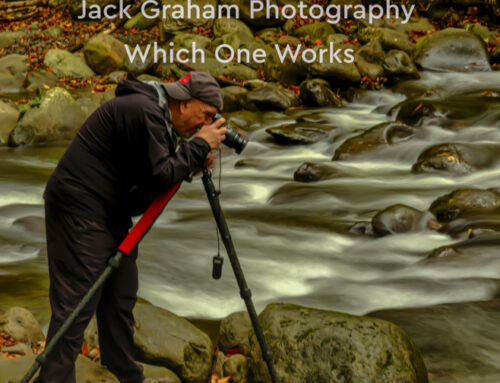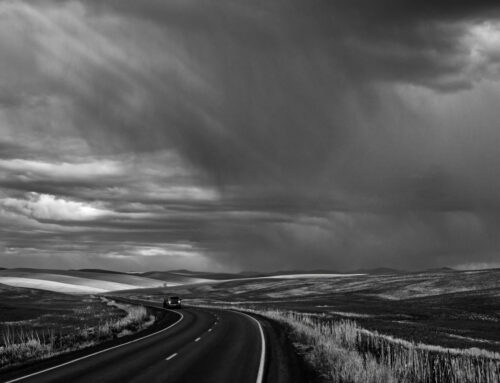In this edition of Which One Works Eastern Washington, I talk about two different shots of a famous tree in the Palouse area of Washington.
LOCATION
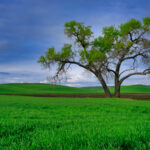 Tennessee Flat Road, near Colfax, WA (Palouse Region of Eastern Washington)
Tennessee Flat Road, near Colfax, WA (Palouse Region of Eastern Washington)
THE SUBJECT: TWO TREES, PALOUSE
This is one of my favorite locations in the Palouse region of Eastern Washington. These are two cottonwood trees growing near a drainage ditch in the wheat fields. These are the only two trees visible and offer a subliminal effect. There are many angles and places to setup to make images, some stronger than others depending on the background, weather, and season.
These trees are very week formed and balanced adding to the image.
Be aware that there is not a lot of parking here and the road is dirt. You can easily get stuck in the mud when before, during and after rain.
THE STORY
These trees, alone in the vastness of the wheat fields tells a story of the emptiness that one feels in this region. You can drive miles on what the locals call “seasonal” roads of dirt, dust and hills that seem never ending. This image tells that story. I made several images to try and convey my feelings with one more successful than the others. Which One Works Eastern Washington is my latest edition, so please keep reading.
As is often the case, these images were made no more than 20 feet apart but depict three different feelings. Therefore, it’s important to slow down and walk around. There was some rain earlier in the day and more moving in which was making the sky somewhat interesting. As well, I was attracted to the slight halo effect that the clouds were giving off around the tree itself. Weather often provides the secret sauce that can make an image work I made three frames. I knew which one would work. So often the last frame is “the one,” and after slowing down, moving around to attain the composition I needed to properly convey my story, I was correct. The last one worked again.
TECHNICAL DATA
All images were made late in the afternoon of May 30, 2022 using a Fujiflm X-T4 and a Fujifilm 16-55 F2.8 R LM WR lens, Really right Stuff Tripod and BH 55 Ball Head, A Breakthrough Photography X-4 CPL Circular Polarizer filter to take the glare off the green wheatfield.. It had been raining very slightly earlier in the afternoon and more light rain was close by, so I was aware of my location and conditions to exit this dirt road safely. Editing was done in Adobe Photoshop and Lightroom as well as NIK Software. B&W conversion was applied using NIK Software, Silver Efex Pro.
___________________________________________________________________
IMAGE # 1
2022:05:30 18:04:12 16-55mm @ 24.9mm —37mm (in 35mm film)
1/35 sec, f/16 Mode: Av Metering: Multi-segment Exp comp: -1/3 ISO: 160
White balance: Daylight
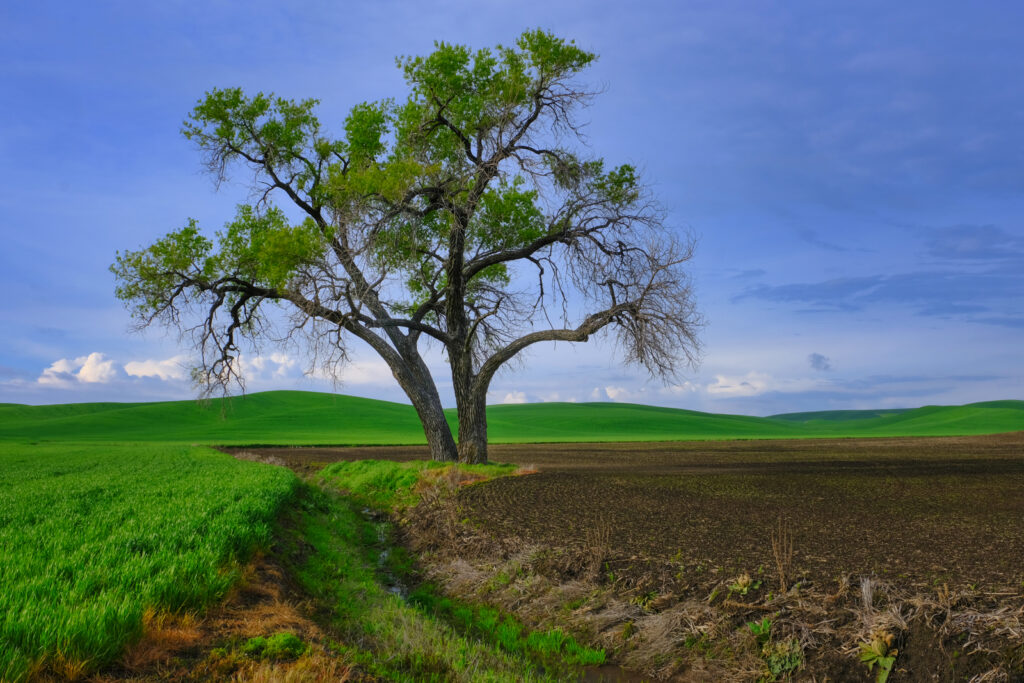
IMAGE # 1
2022 was a strange year in the Palouse. This region has experienced drought conditions in 2021 and into 2022. Many of the fields were unplanted. In a normal year, the field on the right would have been planted and looking like the field on the left. However, I noticed the deep brown, moist soil that offered an interesting contrast to the rich green of the left side and background. Additionally, the brown unplanted field framed the tree trunk and reached out behind the tree. The clouds were building in the sky and offered some interest. Typically, there is water in this ditch, but due to the lack of rain it was almost dry and uninteresting. In a normal spring, this ditch offers a great leading line bring the viewer right into the tress. I made this image to look at on my computer just in case, however I knew that this was not up to standards. The sky offered the slightest of shadow of the tree in the far right but really disappeared in the deep brown soil.
IMAGE #2
2022:05:30 18:01:02 16-55mm @ 24.9mm —37mm (in 35mm film)
1/40sec, f/16 Mode: Av Metering: Multi-segment Exp comp: -1/3 ISO: 160
White balance: Daylight
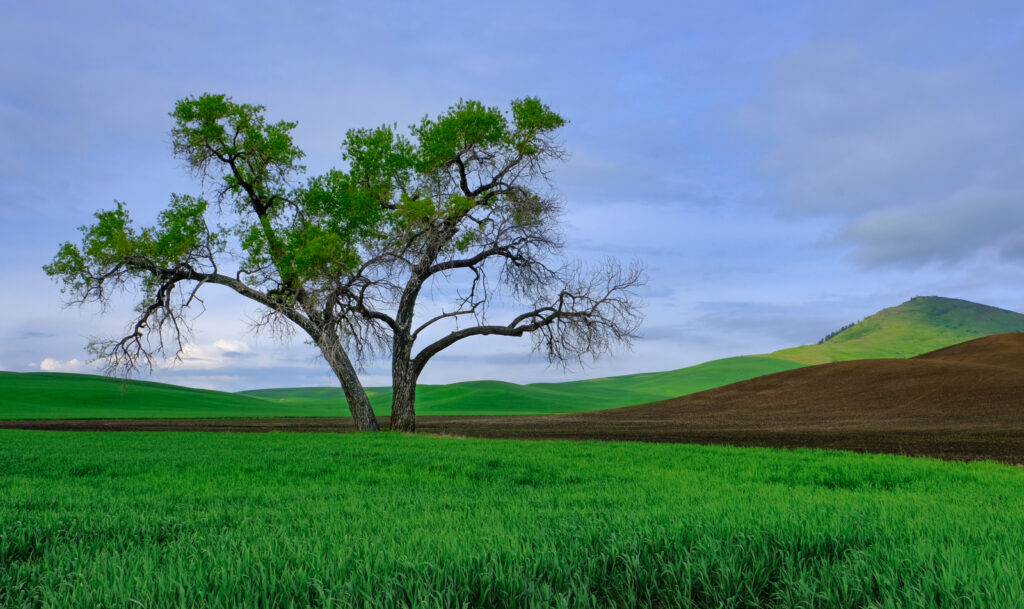
Image #2
Moving over about 20 feet or so offered a different angle on the tree and allowed me to put the peak of Steptoe Butte, a Palouse icon in the background. Again, the brown soil contrasted with the green wheat fields quite nicely and formed an interesting angle.as moved from one side of the frame to the other splitting the green field. I thought that this would be the angle I preferred since having Steptoe Butte included added quite a bit of interest. After viewing it for a while I found myself going back and forth from the peak of the butte to the tree and back, as well as the dark brown unplanted field. The butte added too much interest! More importantly, remember that color can add visual weight to an image. The darker the color, the more visual weight that is added to an image My eye was being pulled away from the tree, the main area of interest, and over to the right where the dark area was. This dark area and combination of the peak of the butte was taking away from the tree and making the image much less “simple”…. An interesting image, but there was just too much going on here and certainly not my final choice.
IMAGE # 3 & 4 (Monochrome)
2022:05:30 17:58:42 16-55mm @ 29.2mm —44mm (in 35mm film)
1/25sec, f/16 Mode: Av Metering: Multi-segment Exp comp: -1/3 ISO: 160
White balance: Daylight
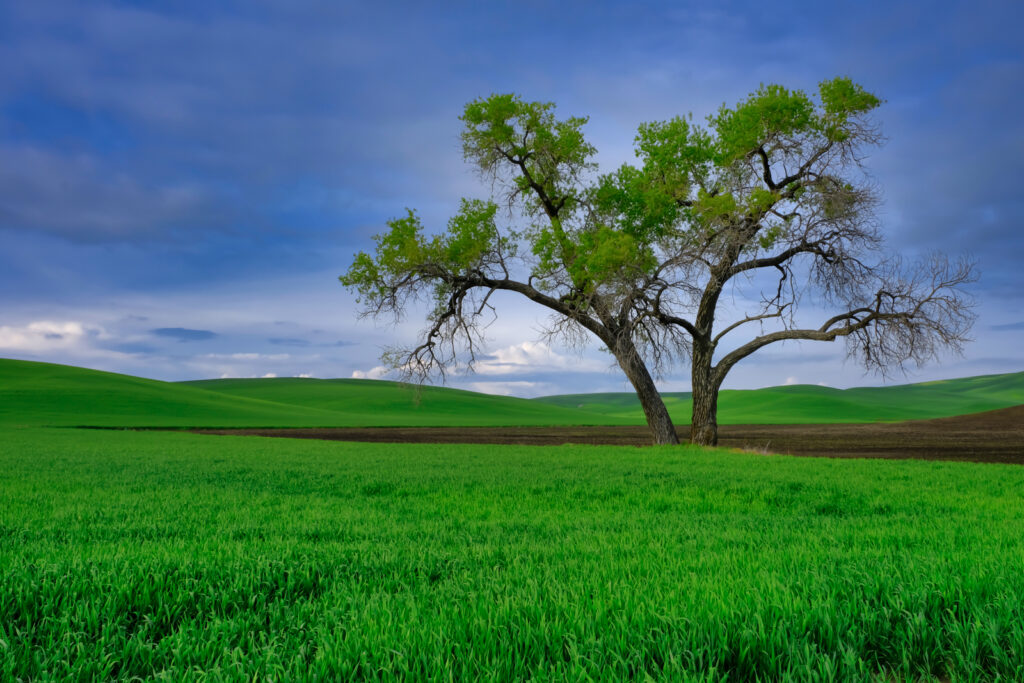
Image #3
I moved once again just about half way between where I was standing for image one and image two. At this angle, the dark unplanted dirt field, is now just adding interest to the composition and not taking over. There was no mountain peak, just the tree with a nice green wheat field in the foreground telling the viewer where the tree grows Having the subject on the right also worked better for me. There is an ever so slight pattern in the wheat field, sort of drawing the eye to the tree. The tree is so perfect in design with a slight halo effect caused by the clouds behind it that having no distractions to the story worked better for me.
There were some clouds in the sky but not having them overly visible also made this image much more simple. Notice the space between the end of the sliver of brown on the left as well as the space between the tree and the right end of the frame. This added a degree of balance to the image. The simplicity of this image really made this an easy choice. For me. This would go into my master file.
IMAGE # 4
But wait!
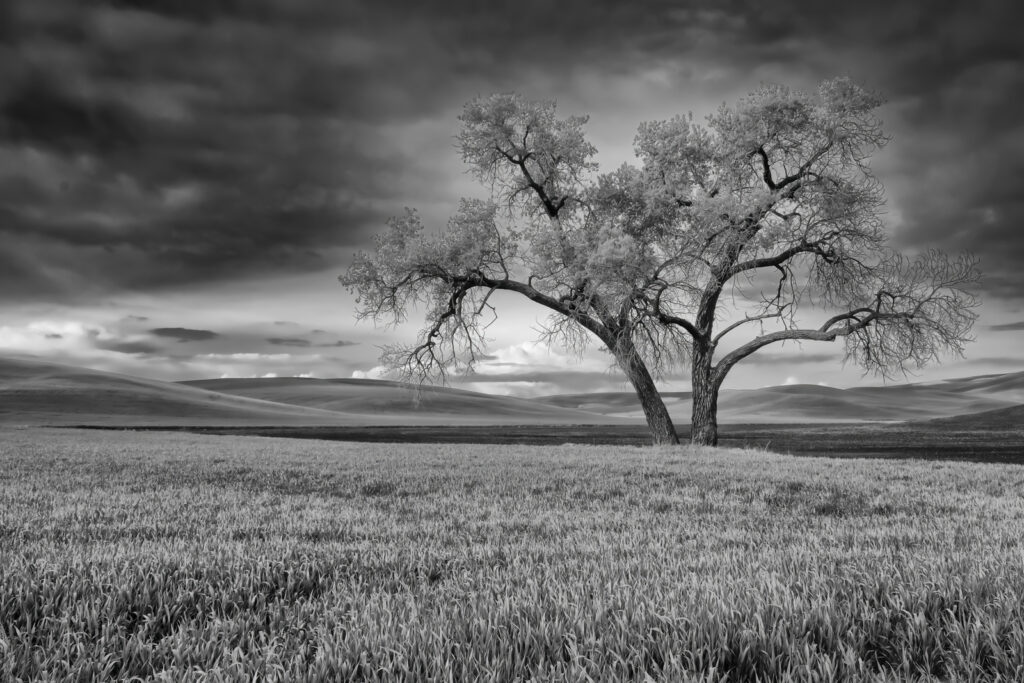
Image #4
I thought about this image for a few days. Then it came to me to see how the image would looking monochrome, using the halo and the clouds to add interest and drama. I used Nik Software Silver Efex Pro for the conversion. I added some contrast and a red filter (strength was backed off to about ½ way) to add drama to the sky. If there was no halo around the tree the monochrome conversion would not have worked, but I was really pleased. I toyed with the idea of eliminating some of the foreground, but I decided not to. First, I am not a cropper, I like to get it right in camera, which to me is the art. Second, the foreground does have some interest as there are some nice lines showing up in the monochrome version slightly more than the color version due to the added contrast. However, most importantly, if I used less foreground the sky may have become more of the story than the tree, so I left everything as is.
So, what was the choice. color or Monochrome. For me both. Both tell two quite different stories. The color doesn’t take away from the story as it some often allowing a monochrome image to be more successful. I really like both for varied reasons and different applications.
What do you think? As always, I’d love to know your comments are always welcome and appreciated
Jack Graham
The right to download and store or output any content on www.jackgrahamphoto.com is granted for preview purposes only and may not be reproduced in any form.
All Photographs appearing on this site are the property of Jack Graham unless otherwise noted.
These photos are protected by U.S. Copyright laws and are not to be downloaded or reproduced in any way without the written permission of Jack Graham
By entering this site you accept these terms. If you need permission to use a photo on this site, please call 503-625-1430 or EMAIL Jack Graham



